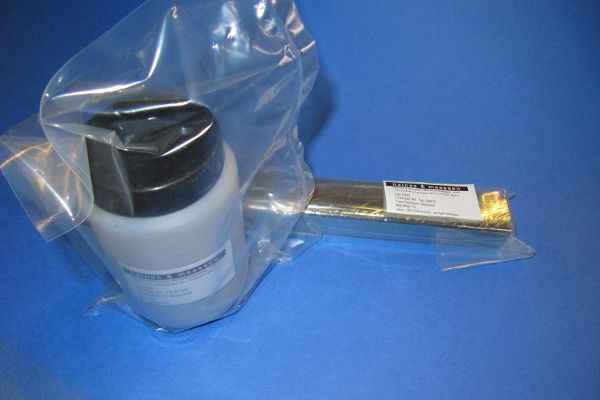Germanium Selenide (GeSe)
13.03.2023
Bulk single Germanium selenide crystal is mostly used as sources from which single or few-layer sheets might be obtained via both mechanical or liquid exfoliation.
Platinum FET Test Chips for 2D Supplies
— Affordable
— World-Vast Transport
— Dual Channel Electrodes
Purchase Online £180
Germanium selenide powder can also be used to arrange GeSe nanosheets and nanoparticles by liquid-exfoliation (normally assisted by sonication).
Key Product Data
— Excessive purity, low price Germanium selenide
— Out there as a powder or as individual crystals
— Can be used to supply single or few-layer sheets
Free worldwide transport on qualifying orders
Construction of Germanium Selenide
Germanium selenide (GeSe) belongs to the Group IV layered metal mono-chalcogenides. It has an analogous construction to phosphorene, and crystallises in a extremely anisotropic layered orthorhombic (distorted NaCl-kind) crystal construction with Pnma symmetry. Every primitive unit cell of the orthorhombic crystal structure incorporates eight atoms organised in adjoining double-puckered layers. The atoms in every double puckered layer bond to their three nearest neighbours by covalent bonds and kind a zigzag chain along the direction of the minor axis of the crystal.
Properties of Germanium Selenide
After exfoliation of crystals or powder, germanium selenide sometimes has the next properties:
— Group IV layered metal mono-chalcogenides
— Puckered layer structure just like that of black phosphorus.
— Orthorhombic (distorted NaCl-type) crystal structure (House group Pnma)
— Chemically-inert surfaces and considerably excessive chemical and environmental stability
— Carefully-positioned direct and oblique bandgaps that overlap effectively with the solar spectrum
Germanium Selenide Applications
Germanium selenide single crystals can be utilized to prepare monolayer and few-layer GeSe by mechanical or liquid exfoliation. Germanium Selenide powder is appropriate for liquid chemical exfoliation to organize GeSe nanosheets and nanoparticles all the way down to few-layer films.
Germanium Selenide is a promising semiconductor for electronic and opto-electronic applications (akin to photovoltaics, phototransistors, thermoelectrics, and power storage devices.
Germanium selenide is a p-type semiconductor with carefully-located direct and oblique band gaps in the range of 1.1 — 1.2 eV. GeSe also exhibits a excessive absorption coefficient of ~105 cm−1 in the seen range and a excessive hole mobility of 128.6 cm2 V−1 s−1, making it a promising semiconductor for electronic and opto-electronic functions (akin to photovoltaics, phototransistors, thermoelectrics, and energy storage devices.
The GeSe layered construction with strongly-pronounced anisotropy of bodily properties is a promising material for the manufacturing of photodetectors, lasers within the near-infrared range, thermo-electric, high-capability lithium ion batteries, and photovoltaic gadgets.
Processing Germanium Selenide
Viscoelastic switch using PDMS
Literature and Critiques
— Electronic construction of germanium selenide investigated utilizing ultra-violet photoelectron spectroscopy, P Mishra et al., Semicond. Sci. Technol., 30, 075001 (2015); doi:10.1088/0268-1242/30/7/075001.
— Structural and electronic properties of atomically thin germanium selenide polymorphs, S. Zhang et al., Sci China Mater., Fifty eight: 929-935 (2015); doi: 10.1007/s40843-015-0107-5.
— Layered materials GeSe and vertical GeSe/MoS2 p-n heterojunctions, W. Yap et al., Nano Res., 11(1): 420-430 (2018); doi: 10.1007/s12274-017-1646-8.
— Germanium and Tin Selenide Nanocrystals for high-Capability Lithium Ion Batteries: Comparative Section Conversion of preis germanium and Tin, H. Im et al., J. Phys. Chem. C, 118, 21884−21888 (2014); dio: 10.1021/jp507337c.
— Brief-Wave Near-Infrared Linear Dichroism of Two-Dimensional Germanium Selenide, X. Wang etal., J. Am. Chem. Soc., 139, 14976-14982 (2017); DOI: 10.1021/jacs.7b06314.
— Temperature induced phonon behaviour in germanium selenide thin movies probed by Raman spectroscopy, J. Phys. D: Appl. Phys., Forty nine, 315301 (2016); doi:10.1088/0022-3727/49/31/315301.
— Band Structure and Photoelectric Characterization of GeSe Monolayers, H. Zhao et al., Adv. Funct. Mater., 28, 1704855 (2018); DOI: 10.1002/adfm.201704855.
— Nanocomb Architecture Design Using Germanium Selenide as High- Performance Lithium Storage Material, H. Kim et al., Chem. Mater., 28, 6146−6151 (2016); DOI: 10.1021/acs.chemmater.6b02016.
— GeSe monolayer semiconductor with tunable direct band hole and small carrier efficient mass, Y. Hu et al., Appl. Phys. Lett. 107, 122107 (2015); doi: 10.1063/1.4931459.
— Two-Dimensional GeSe as an Isostructural and Isoelectronic Analogue of Phosphorene: Sonication-Assisted Synthesis, Chemical Stability, and Optical Properties, Y. Ye et al., Chem. Mater., 29, 8361−8368 (2017); DOI: 10.1021/acs.chemmater.7b02784.
— Anisotropic Spin Transport and Strong Visible-Light Absorbance in Few-Layer SnSe and GeSe, G. Shi et al., Nano Lett., 15, 6926−6931 (2015); DOI: 10.1021/acs.nanolett.5b02861.
— Band Construction and Photoelectric Characterization of GeSe Monolayers, Adv. Funct. Mater., 28, 1704855 (2018); DOI: 10.1002/adfm.201704855.
— Extremely Anisotropic GeSe Nanosheets for Phototransistors with Ultrahigh Photoresponsivity, X. Zhou et al., Adv. Sci., 5, 1800478 (2018); DOI: 10.1002/advs.201800478.



